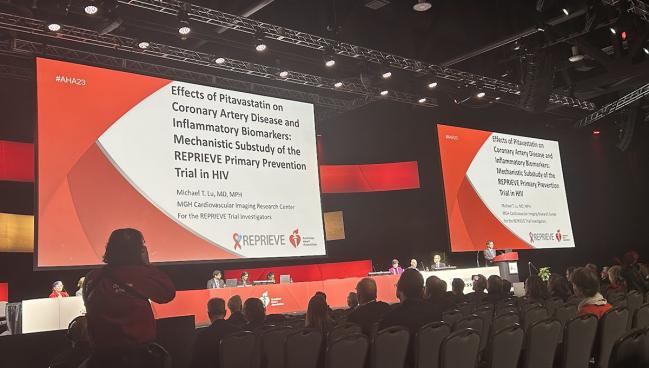Reductions in Plaque, Inflammation Appear to Explain Statin Benefit in HIV
A REPRIEVE trial substudy shows 2 years of pitavastatin lessened noncalcified plaque volume and risk of plaque progression.

PHILADELPHIA, PA—Among people living with HIV, pitavastatin for primary prevention of CVD appears to reduce the risk of adverse cardiovascular outcomes through beneficial effects on plaque and inflammation, according to a substudy of the REPRIEVE trial.
After 2 years of treatment, pitavastatin-treated patients had reductions in noncalcified plaque volume and the risk of plaque progression, as well as drops in biomarkers of lipid oxidation and arterial inflammation, Michael Lu, MD (Massachusetts General Hospital, Boston), reported recently here at the American Heart Association (AHA) 2023 Scientific Sessions.
“These observed changes may contribute to the 35% reduction in MACE observed with pitavastatin in the parent REPRIEVE trial,” he said, noting that a prior meta-analysis of IVUS studies showed that changes in plaque as small as 1% can lead to substantial reductions in MACE risk.
Patients with HIV infection, which is characterized by inflammation and a higher noncalcified coronary plaque burden, have up to double the risk of CVD compared with the general population, Lu said.
The REPRIEVE trial was designed to assess the impact of pitavastatin—a moderate-intensity statin with minimal interaction with antiretroviral therapy—in patients with HIV infection and a low-to-moderate predicted 10-year risk of atherosclerotic CVD. The main results demonstrated that pitavastatin, through a median follow-up of 5.1 years, reduced the rate of MACE (CV death, MI, stroke, unstable angina, stroke, TIA, or arterial revascularization) from 7.32 to 4.81 per 1,000 person-years.
Lu said the 35% relative reduction in MACE risk could not be fully explained by the reduction in LDL cholesterol alone, so he and his colleagues took a deeper dive into the mechanistic impact of pitavastatin. The substudy included 804 participants (mean age 51; 17% women) from 31 US sites; all underwent coronary CT angiography for an assessment of coronary plaque volume and composition. The projected 10-year risk of atherosclerotic CVD in this cohort was about 4.5%, indicating a “relatively low-risk group,” Lu said.
Over 2 years, the volume of noncalcified plaque declined by 4.3 mm3 (7%) relative to placebo overall, and by 8.8 mm3 (12%) among the patients who had plaque detected at baseline. There was also a 1.2-mm3 greater reduction in low-attenuation plaque, “which is thought to be particularly biologically active and high risk,” with pitavastatin versus placebo, Lu reported.
Moreover, the risk of noncalcified plaque progression was lower in the pitavastatin arm (18% vs 28%), representing a 33% relative reduction.
Looking at lipid and inflammatory biomarkers, pitavastatin led to greater drops in LDL and non-HDL cholesterol, as well as Lp-PLA2 and oxidized LDL. There was a nonsignificant trend toward lower high-sensitivity C-reactive protein.
Both a greater change in LDL cholesterol and achievement of an LDL level below 70 mg/dL appeared to be associated with a lower risk of noncalcified plaque progression, but the relationships were not statistically significant after adjustment for baseline plaque.
Statins for All HIV Patients?
Discussing the results after Lu’s presentation, Priscilla Hsue, MD (University of California, San Francisco), noted that the substudy confirms a smaller study performed using atorvastatin, which also demonstrated a reduction in noncalcified plaque in patients with HIV.
In the current study, the impact on noncalcified plaque was mostly driven by the reduction in LDL cholesterol, with more-modest effects on inflammatory biomarkers, Hsue said, adding that it’s unclear what the results would have been with a high-intensity statin. “It’s clear that additional anti-inflammatory strategies will be needed to reduce cardiovascular risk in the setting of HIV infection,” she said.
Hsue pointed to a meta-analysis published earlier this year, in which the authors predicted that a combination of aggressive lipid-lowering and anti-inflammatory therapies might become the standard approach for treating atherosclerotic disease in the future. “I think we should think about collectively what therapeutic strategies should be used to lower inflammation in HIV,” she said.
There are some open questions around the management of cardiovascular risk in patients with HIV infection, Hsue indicated, including whether there would be a benefit to going even lower with LDL cholesterol by using nonstatin therapies. Her group and Lu’s group are collaborating on the EPIC-HIV trial to study the impact of PCSK9 inhibition in HIV-infected patients.
“And certainly in the context of this late-breaking session, all of these therapies that were discussed merit further discussion in the setting of HIV infection,” Hsue said, alluding to results of studies of gene editing, a new PCSK9 inhibitor, and a short-interfering RNA (siRNA) therapy also presented at AHA.
One issue that has held back efforts at CVD prevention in the setting of HIV is the inaccuracy of traditional risk calculators for this population, Hsue said, noting that studies have shown evidence of atherosclerosis on imaging among HIV-infected patients with a low predicted risk of CVD. “This makes one wonder: should we consider imaging in asymptomatic individuals to do a better job at risk prediction?”
Todd Neale is the Associate News Editor for TCTMD and a Senior Medical Journalist. He got his start in journalism at …
Read Full BioSources
Lu MT. Effects of pitavastatin on coronary artery disease and inflammatory biomarkers: mechanistic substudy of the REPRIEVE primary prevention trial in HIV. Presented at: AHA 2023. November 12, 2023. Philadelphia, PA.
Disclosures
- REPRIEVE is funded by the National Heart, Lung, and Blood Institute (NHLBI), the National Institute of Allergy and Infectious Diseases, Kowa Pharmaceuticals, Gilead, and ViiV Healthcare, with support from the AIDS Clinical Trials Group and the Division of AIDS.
- Lu reports unrelated research funding to Massachusetts General Hospital from the American Heart Association, AstraZeneca, Ionis, Johnson & Johnson Innovation, the NHLBI, the National Academy of Medicine, and the Risk Management Foundation of the Harvard Medical Institutions Incorporated.
- Hsue reports honoraria from Gilead and Merck; study drug from Regeneron, Novartis, and Eli Lilly; and grant support from Novartis and Eli Lilly.





Comments